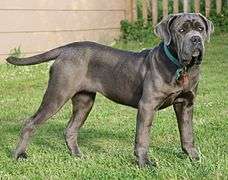Neapolitan Mastiff
 | ||||||||||||||||||||||||||||||
| Other names |
Mastino Mastino Napoletano Italian Molosso Can'e presa | |||||||||||||||||||||||||||||
|---|---|---|---|---|---|---|---|---|---|---|---|---|---|---|---|---|---|---|---|---|---|---|---|---|---|---|---|---|---|---|
| Origin | Italy | |||||||||||||||||||||||||||||
| ||||||||||||||||||||||||||||||
| Domestic dog (Canis lupus familiaris) | ||||||||||||||||||||||||||||||
The Neapolitan Mastiff or Mastino (Italian: Mastino Napoletano) is a large, ancient dog breed. This massive breed is often used as a guard and defender of family and property due to their protective instincts and their fearsome appearance.
Appearance
According to the American Kennel Club (AKC) standard, male Neapolitan Mastiffs should measure 26–31 inches (66–79 cm) at the withers, weigh 130–155 pounds (60-70 kg), while females should measure 24–29 inches (61–74 cm) and weigh 110–130 pounds (50–60 kg).[1] Body length should be 10–15% greater than height.
The Neapolitan Mastiff is large and powerful. Their bodies are covered in loose skin with a coat that can either be black, blue, mahogany or tawny.[2]
Temperament

The Neapolitan Mastiff is fearless and extremely protective of its home and family. They prefer to be with their family. The Neapolitan Mastiff rarely barks unless under provocation, renowned for sneaking up on intruders as opposed to first alerting them of its presence.
Neapolitan Mastiffs, as a breed, are extremely intelligent dogs with a tendency to be independent thinkers. They learn quickly, which is both good and bad, since this guardian breed needs extensive proper socialization to learn to accept strangers, especially within the home; without proper early socialization and training, these dogs are likely to become aggressive towards strangers and unfamiliar dogs.
The Neapolitan Mastiff is not a breed for most people, and certainly not a dog for beginners. Neapolitans must be well socialized with people (especially children), as they are large, powerful dogs and do not always know their own strength. Additionally, young children have young friends, and even with extensive socialization and training, Neapolitans will be wary of strangers and protective of their family, which can be disastrous for small children. Most of the time, they will protect their owners with their lives.
Additional protection training is unnecessary because they are natural guard dogs and always have been. As with every breed, obedience training is very important. The Neapolitan is very tolerant of pain due to the breed's early fighting background and the fact the skin is loose on the body, so it is important to routinely check for health problems, as a Neapolitan may not behave differently when injured or ill. They also are renowned for drooling especially after drinking or if they get excited.
The Neapolitan Mastiff has a low activity level, even as a puppy. Visits to dog parks should be minimal, considering they can be aggressive to other dogs they are not familiar with. The ideal environment for this breed is in its home with a large yard and a fence five or six feet high.[3]
Health

The Neo has some specific health concerns. The most common is Cherry eye. Others include:
- Hip dysplasia
- Ectropion
- Entropion
- Elbow dysplasia
- Sebaceous adenitis
- Progressive retinal atrophy
- Hypothyroidism
- Cardiomyopathy
- Bloat
- Skin infections between skin folds called Pyoderma
- Anesthetic Sensitivity
Like most giant breeds, the Neapolitan Mastiff has a relatively short life expectancy. UK breed club surveys puts the average at 7 years, with 1 in 6 living to 9 years or more.[4]
Care and maintenance
When it comes to exercise, Neapolitans should be exercised lightly with walks and moderate safe-training. They can be a very active breed with the correct vested time and care. Endurance and drive can be honed and harnessed with the correct amount of diet, exercise and consideration to joint care and maintenance (do not expect this breed to jump obstacles, although it is not impossible for the task to be accomplished). Be very careful as the Neapolitan Mastiff is a very powerful breed and given their massive weight when bred and raised correctly can display extremely powerful bursts of energy.
History
The Neapolitan Mastiff is one of the Molosser type of dogs, which probably descend from a common stock; whether this was the Molossus attested in antiquity is controversial.
Despite centuries of popularity throughout Europe, this type of dog was almost lost after World War II. Soon after the war, Italian painter Piero Scanziani established a breeding kennel to turn the Mastiff-type dogs of Italy into a formal breed which was then named the Neapolitan Mastiff and English Mastiff was used to help in this process.
Neapolitan Mastiffs were also trained to bait bulls, bears and jaguars.[5]
Gallery
- Neapolitan Mastiff
- Male Neapolitan Mastiff
 Neapolitan Mastiff profile
Neapolitan Mastiff profile Male Neapolitan Mastiff 1998
Male Neapolitan Mastiff 1998- A "blue" Neo puppy
References
- ↑ "Official Standard of the Neapolitan Mastiff" (PDF) (pdf). American Kennel Club. January 13, 2004. Retrieved 2016-01-18.
- ↑ Palmer, Joan (February 2006). Dog Breeds. Wellfleet, MA: Wellfleet Press. p. 157. ISBN 978-0785800309.
- ↑ "VetStreet". VetStreet. Retrieved October 21, 2015.
- ↑ "Average Age Survey Results". The Neapolitan Mastiff Club. Retrieved 26 February 2015.
- ↑ "Facts about NEAPOLITAN MASTIFFS ***". Facts-about.org.uk. Retrieved 2012-06-25.
External links
| Wikimedia Commons has media related to Neapolitan Mastiff. |